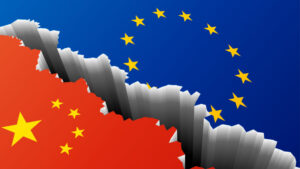Goodbye, Asia? Companies shifting business back to Europe amid lack of trust
In the wake of the pandemic, Western European companies have begun moving production from the Far East back to Europe. The impact of nearshoring can already be felt in Hungary, Synermont CEO Krisztián Kavas told us. The contract manufacturing company has seen quick success, with orders flooding in from around the continent, from Austria to Sweden.

During the great lockdown, when Covid-19 basically shut down the global economy, many predicted that Western companies would start shifting manufacturing back from Asia. Synermont Ltd was founded as a contract manufacturer in 2021. Has the plan always been to ride this trend?
That’s right, we started the company in May 2021, during the third wave of Covid . We saw a strong market demand, and the first order didn’t take long to come after that. We couldn’t believe our eyes and did survey after survey to find out if we’d just been lucky and whether our success was a one-off fluke or part of a bigger trend. We found that this was the new reality, so we dived in.
When it comes to contract manufacturing, most people think of Asian countries with low production costs. Has the world really changed so dramatically that it’s now worth bringing production to Europe?
Before the pandemic, manufacturing costs were up to 70 per cent cheaper in China and India. No wonder offshoring had been booming for decades, and whoever could, outsourced their production.
Yet, the tide is turning. Because of Covid, logistics costs have exploded, and shipping has also become more difficult. That’s where nearshoring, bringing production closer to home, comes in.
Big Western European companies who had been reaping huge profits from manufacturing their products in the Far East, suddenly experienced the downsides of it all. So now they’re on the lookout for opportunities to move production to Central and Eastern Europe, where costs are a bit higher but it’s still way more affordable than back home. This is the niche we’ve taken advantage of. What we’ve seen is that there’s a great demand for manufacturers who work to tight deadlines and are basically round the corner.
With high-end, premium products, the need for quality production, efficient communication, quick response times as well as a flexible and proactive approach tips the scales in favour of nearshoring even more. We basically breathe together with our clients and work as their extended hands.
Have many other Hungarian companies jumped on the opportunity?
Not yet. Although there are a lot of contract manufacturing companies in the country, the majority of them serve only one client, usually focusing on one particular area. By contrast, we, having spent more than a decade each in the automotive industry, could successfully execute nearly any project that comes our way.
What does it mean that “costs are a bit higher” in Central and Eastern Europe? Where are we compared to China?
Production in China is still 50 per cent cheaper than in Hungary, but this doesn’t include logistics.
That’s the price we can do. In fact, we weren’t originally planning to compete with the Far East, it just happened as we started receiving loads of inquiries. The nearshoring trend has begun exerting its effect in the past three or four months.
Are logistics costs so significant?
I’ve been told that if shipping a container cost 3,000 euros before, it now costs somewhere between 15,000 and 18,000 euros. Needless to say this makes manufacturing in Asia much pricier than before. It might make sense to transport smaller products by air, but it’s doubtful. We’ve been contacted by a Swedish company recently, for example. They manufacture health care equipment in China, but only a couple of their products fit into each container and they then spend four months rocking at sea. That’s why they’ve decided to search for a solution closer to home. And that’s our competitive advantage.
When did you notice that your order volume had increased?
We registered the company in May 2021, and with the help of CED Central European Economic Development Network Nonprofit Ltd, we first approached the Austrian market. Through CED, we connected with many potential clients and soon received our first order. It was a great help, as we got our foot in the door and could grow quicker.
Our first contract manufacturing project, the production of special, innovative bicycle inner tubes, began in July 2021. The client designed the production line, which was then jointly installed in our plant in Sopron. Work started with just 15 people.
By the end of September, we had received so many orders that we had to double our workforce, working in two shifts. New projects have constantly been coming in ever since, and we keep growing.
Do you think the nearshoring trend is here to stay? Will the success story continue? Is it worth investing in contract manufacturing in Hungary?
Yes, I think so. If the energy crisis isn’t resolved soon, nearshoring will become even more attractive for Western European businesses. Of course, it’s yet to be seen how much companies will be willing to make long-term strategic decisions and commitments in today’s turbulent environment. In this sector, signing an agreement usually takes 6 to 12 months.

Krisztian Kavas Co-founder of Synermont


